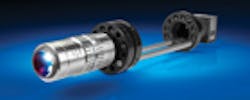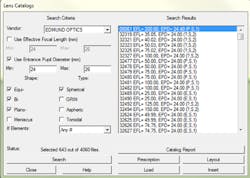Designing with Stock Optics
Using off-the-shelf optics in your next design project comes with many advantages. If budget or time restrictions eliminate the possibility of utilizing custom optics in your application, stock optics are readily available and easily implemented to fit your design requirements. Here are some quick tips to help make designing with off-the-shelf optics easy.
1. Simplify
Start on paper with a paraxial design and break it into subsystems of finite and infinite conjugate optical groups. Determine the focal lengths you want for each group on paper before trying to optimize in a code like Zemax, Code V, or another ray tracing software of your choice. Once you have the focal lengths required, you can start using paraxial equations to help choose the off-the-shelf lenses that provide the required focal lengths. Your preferred ray tracing code should have a selection of off-the-shelf lenses built into it (Figure 1) that you can use to model the selected lenses and optimize your spacing. If not, the lenses can typically be input into the software with the information provided by the supplier. All EO TECHSPEC® components are available in most design codes and Zemax files are available on our website.
Figure 1: Lens Catalog from Zemax
2. Go Monochromatic
If at all possible, use a monochromatic source such as an LED or Laser or use an optical filter to make your system monochromatic. Using a monochromatic or narrow band light will greatly reduce the complexity of the design. As a rough guideline, reducing the source waveband to less than 50nm will generally make using singlets possible in your design. Chromatic aberrations cause difficulty when composing a design, so your options will be simplified if a broadband light source is not required.
To find out what the remaining tips are, click here to download PDF!
About Sponsor
Edmund Optics is a leading supplier of optics and optical components, designing and manufacturing a wide array of multi-element lenses, lens coatings, imaging systems, and opto-mechanical equipment. EO’s state of the art manufacturing capabilities combined with its global distribution network has earned it the position of the world’s largest supplier of off-the-shelf optical components. Customers can purchase items by calling 1-800-363-1992, via the catalog or the website at http://www.edmundoptics.com/

